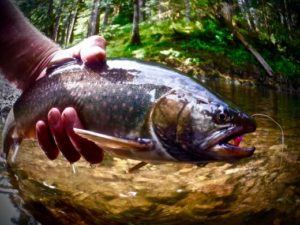Winter is Tenkara Time
By Jack Bombardier, Confluence casting Most anglers put their rods away once the snow starts to fall, and break out their skis or retreat to the tying bench. But a new tool has emerged over the past few years which has to potential to revolutionize the way we think about fishing during the “off season,” and that is the tenkara rod. Tenkara-style rods are usually around 12 feet long, with a fixed line and leader combination of 14 to 20 feet that comes straight off the tip of the rod. Tenkara setups use no reel whatsoever, and make fly fishing even easier than spin fishing. I guide float-fishing trips on the Upper Colorado River and have had days where novice anglers using tenkara rods have out-fished more experienced fishermen using conventional rods.
By now you’ve probably already heard about tenkara, and maybe even tried it yourself. The rods were brought to America by Daniel Galhardo of Tenkara USA, but there are now several different companies selling them at various price points and levels of quality. It is true that there are situations in which tenkara setups aren’t optimal, and that would include wade fishing big rivers, angling for large prey, and windy days.
 But there is one scenario where tenkara rods really shine, and that is for winter tailwater fishing. Colorado is home to many productive winter fisheries, most located below big dams. Tailwaters include the Blue River below Dillon Reservoir, the Frying Pan below Ruedi, the Yampa below Stagecoach, and the Taylor, to name a few. What these waters have in common is a steady flow of (relatively) warm water flowing all winter that is conducive to insect hatches, and in turn to feeding fish. Waters like this are justifiably famous for the big trout they produce, but fishing them during the high season usually means casting right beside many others doing the same thing. The nice thing about visiting them in the winter when everyone else is on the slopes, or inside nice and warm and dreaming of April, is that you can often have these normally busy waters all to yourself.
But there is one scenario where tenkara rods really shine, and that is for winter tailwater fishing. Colorado is home to many productive winter fisheries, most located below big dams. Tailwaters include the Blue River below Dillon Reservoir, the Frying Pan below Ruedi, the Yampa below Stagecoach, and the Taylor, to name a few. What these waters have in common is a steady flow of (relatively) warm water flowing all winter that is conducive to insect hatches, and in turn to feeding fish. Waters like this are justifiably famous for the big trout they produce, but fishing them during the high season usually means casting right beside many others doing the same thing. The nice thing about visiting them in the winter when everyone else is on the slopes, or inside nice and warm and dreaming of April, is that you can often have these normally busy waters all to yourself.
The two main obstacles to winter fishing are rod guides that ice up and freezing hands, but tenkara rods solve both problems. (Freezing feet can also be a problem, but if you stand in the 40 degree water instead of the 10 degree air on the bank it helps!) Tenkara rods have no guides to accumulate ice, so that’s one problem completely eliminated. As for your hands, a tenkara only requires the use of one to hold the rod, so the other hand can stay warm in your pocket. The hand holding the rod can be clad in a snowmobile mitten if conditions dictate, since tenkara rods don’t need delicate hand coordination to fish with. The only time you’ll get your hand wet is when landing a fish, but using barbless hooks can greatly reduce the amount of fish handling necessary when you do land one.
Flows coming out of dams are usually low, but low water like that is perfect for tenkara. Tenkara rods are mostly promoted as a way to fish small streams and headwaters, and they are great for that. But the more I use them, the more other situations I realize they are good for. Beginning fisherfolk? Check. Kids, or the elderly who no longer have good hand-eye coordination? Check. Backpackers, or people fishing from horseback or mountain bike? Check. Fishing from a boat, where casts are often fairly short? Check. But of all the varied uses of tenkara rods, there is none where they give you a bigger edge than for winter fishing. Once you’ve used a tenkara rod on your favorite tailwater, you’ll never take your regular rig out again when temperatures dip below freezing.
Jack Bombardier is a fly-fishing guide and TU member who owns and operates Confluence Casting on the Colorado River.